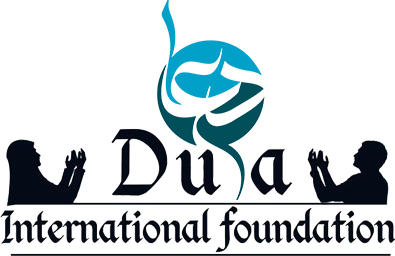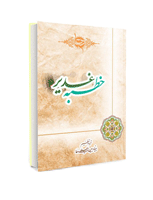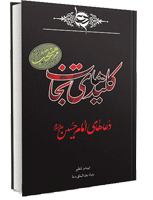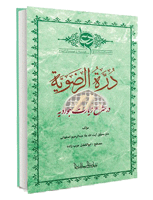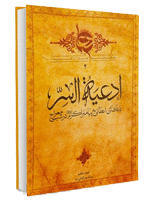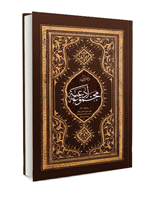- Prophet Muhammad (P.B.U.H): Whenever one of you is needy and brings that to other people, he will not be satisfied. and Whenever someone is needy and brings that to Lord, he shall give him what he wants. sooner or later.
- Imam Sadiq (As.): Whenever you had tenderness in your heart, Pray. because your heart doesn't get tender unless it's pure.
- I told to Imam Baqir (A.S): “What is the meaning of “truly, Ibrahim was awwah and patient”? He replied: “Awwah means (the one who is) praying (to) and wailing (for God) a lot.””
- “Two people, who have acted alike, enter the heaven, but one of them sees the other one in a higher place. Then, he says: O’ Lord! How come has he a superior place in comparison to me while we acted alike? God the Almighty replies: “because he asked Me (whatever he needed) and you did not do that”.
- “The most knowledgeable person to God is the one who asks more from Him”
- “Whoever prays a lot, the angels say: this voice is familiar (to us) and this is the prayer which is accepted and this is the need which is provided”
- “There is no servant who goes to a land and opens their hands and praises God and prays, unless God fills the land with his rewards, whether it is vast or tiny”
- If you knew god the way you should’ve known, Mountains definitely will be moved by your prayers.
- Crying out of fear of god is the key to his mercy, it’s a sign for his acceptance and it’s a door to answering (your prayers)
- Pray to god and believe in his answeres. But understand that god wont accept prays from an unwitting oblivious heart.
Research on
بسم الله الرّحمن الرّحیم
Research on "Study of the Intertextuality of the Testaments in Simāt Supplication”
Authors: Zahra Niconezhad, Hossein Khakpour, Waliullah Hasoumi
Translator: AbdolQhadir Mojahid Ghaznavi
Simāt Supplication (دعای سَمات) and Old Testaments
Foreword
Existence of similarities between multiple texts indicates that there must be a relationship in between. This similarity can depict itself in the repetition of the same phrases or the same concept. However, in these cases, there comes the possibility that one of these two texts is whether influenced by the other or both have been issued by a single author. In fact, texts featuring such sort of characteristic, express common concepts and terminologically speaking, there is a common ground between them. This type of method, is called as "intertextuality".
What is intertextuality?
In a simple statement, theorists believe that there is no completely new text and all texts, whether literary or non-literary, are formed based on the systems and traditions created by past literary texts, and naturally you find some similarities between them. Regarding this method, sometimes the similarity is the repetition of phrases (quoting), which is called “partial negation”, or it indicates a conceptual relation between expressions which is called “parallel negation”. In this type of review, the author’s innovation is not illustrated, but it is depicted in the utilized language. Reviewing the texts while using the intertextual method, the text that is earlier in terms of history and time, is called as the “absent text” and the text which is written later in terms of time, is called as the “present text”.
Terminological meaning
Intertextuality is the creation of a new text by linking other texts. Based on this definition, all texts are intertextual, and due to the Parallel negation of formal components or the inevitable Parallel negation of overlapping literary methods, intertextuality is a fully accepted method.
Rules and elements of intertextuality
The "rules of intertextuality" govern on re-recreation of a text by utilizing the intertextual elements,
Intertextuality has three main pillars:
The absent text, which is also called as the hidden-text or pretext.
The present text, which is also called the post-text.
The intertextual relations.
Intertextuality Types
Partial negation[1]
Parallel negation[2]
Total negation (Discourse)[3]
Partial negation
Regarding this type of intertextual relationship, the author of the present text consciously quotes a part of the absent text in his own text; This method, which we know as the “direct quotation”, is the most superficial type of intertextual relationships.
Parallel negation
In this type, which is a quite more creative method than the previous one, the author uses the absent text, and in the present text, the main essence of the absent text is depicted in a new format. This method is also known as "indirect quotation" or "paraphrasing".
Discourse
In the third type, which is the highest type of impact and impression, only subtle traces of the absent text exist in the present text and sometimes appears in the present text with a contradictory content which in other words, we call it as “open interpretation of the text”.
The relationship between Simāt supplication, the New and Old Testaments (Bibles) and intertextuality
Due to the presence of similar phrases in the precious supplication of Simāt and the Christian Bible, which we call the Testaments, the investigation of the intertextual relationship between these two texts has been put under consideration. The existing type of intertextuality between the Simāt supplication and the Testaments, is of the Partial negation type of intertextuality.
The Simāt Supplication
This dua (supplication), which is also known as the "Shaboor" supplication, is a supplication which includes religious and historical content, narrated by Imam Baqir and Imam Sadiq, peace be upon them. The content of this supplication, which is ordered to be recited on Friday evening (prior to sunset), includes the wonders of creation, the mission of prophets, the miracles of the messengers of God, swearing by the sacred beings and things, and beseeching mercy and forgiveness from God. One of the main reasons for naming this supplication (as Simāt) is the fact which it contains the signs of the absolute power of God; Because Simāt (سِمات) is the plural form of "Simah (سِمه)" which means sign.
Imam Baqir, peace be upon him, says about this supplication: “...this supplication is of the secret sciences and of the responded treasured issues to God.”[4]
Testaments
By Testaments we mean the Bible accepted by Jews and Christians, which is divided into Old and New Testaments:
Old Testament: It is that part dedicated to the old writings of the Jews, which includes three parts:
- Law or Torah
Numbers, Genesis, Exodus, Leviticus, Deuteronomy
- Prophets
- Holy writings
The Torah itself is comprised of 5 sections that form the 5 principles/foundations of the 39-part of the Old Testament. These 5 parts, which are called "Pentateuch", describe the laws governing the Jewish community, after settling in the land of Canaan until the death of Moses, peace be upon him, and the oldest of them is Deuteronomy.
There are other books, as well, such as: Psalms, Proverbs, Judges and Joshua, whose content is sometimes mixed with legends and stories and in a way tells the Jewish history since 1200 BC.
New Testament: which consists of several books:
- Four Gospels, which express the instructions based on the life of Jesus (PBUH);
- Matthew, Mark, Luke, John
- The Acts of the Apostles, which deals with the events after the crucifixion of Jesus (PBUH)
- Letters and epistles written by Paul
- John's Revelation, which deals with the apocalyptic matters or the end of the world and God's judgment on His servants.
Creation
One of the most important goals of the apostles/prophets of God is to draw the attention of mankind to the Lord and to know Him through the description of creation modality and the way the universe was created and pointing to the Divine wisdom, to be a motivation for gratitude and recognition of the rights of creatures. The same issue is one of the commonalities of Simāt and the Testaments’ supplications:
«...وَ بِكَلِمَتِكَ الَّتِی خَلَقْتَ بِهَا السَّمَاوَاتِ وَ الْأَرْضَ وَ بِحِکْمَتِكَ الَّتِی صَنَعْتَ بِهَا الْعَجَائِبَ وَ خَلَقْتَ بِهَا الظُّلْمَهَ وَ جَعَلْتَهَا لَیْلاً وَ جَعَلْتَ اللَّیْلَ سَكَناً [مَسْكَنا] وَ خَلَقْتَ بِهَا النُّورَ وَ جَعَلْتَهُ نَهَاراً وَ جَعَلْتَ النَّهَارَ نُشُوراً مُبْصِراً وَ خَلَقْتَ بِهَا الشَّمْسَ وَ جَعَلْتَ الشَّمْسَ ضِیَاءً وَ خَلَقْتَ بِهَا الْقَمَرَ وَ جَعَلْتَ الْقَمَرَ نُوراً...»
“…and through Your Word By which You have created the heavens and the earth, and through Your Wisdom, with which You have created wonderful, and with which You created Darkness and made it Night, and made night the time of quiet and rest; and with which You created Light and made it Day, and made day the time of movement and observation; and with which You have created the Sun, and made the sun radiant, and with which You have created the Moon, and made the moon a light …”[5]
“In the beginning God created the heavens and the earth.
Now the earth was formless and void, and darkness was over the surface of the deep. And the Spirit of God was hovering over the surface of the waters.
And God said, 'Let there be light', and there was light. And God saw that the light was good, and He separated the light from the darkness. God called the light 'day', and the darkness He called 'night'.
And there was evening, and there was morning—the first day.
And God said, 'Let there be an expanse between the waters, to separate the waters from the waters.' So God made the expanse and separated the waters beneath it from the waters above. And it was so. God called the expanse 'sky'.
And there was evening, and there was morning—the second day.
And God said, 'Let the waters under the sky be gathered into one place, so that the dry land may appear.' And it was so. God called the dry land 'earth', and the gathering of waters He called 'seas'. And God saw that it was good.”[6]
Comparing these two texts, the intertextual method of Partial negation is quite clear; Imam Sajjad (peace be upon him) has used expressions in the text of the supplication that are also mentioned in the Holy Bible.
Manifestation
Manifestation of God in creatures
Manifestation is a mystical meaning mentioned in many verses of the Qur'an and the content of many supplications. And the meaning of manifestation is the shining of divine light on the mystic's heart and the realization of a kind of revelation for him and the intuitive understanding of God. The meaning of God's manifestation is the advent of God through signs. As mentioned in verse 143 of Surah A'araf.[7]
In the Testaments and Simāt supplication, this manifestation has been presented in various expressions:
Faran[8]
Faran (Paran) is a mountain in the children of Israel deserts which today is known as Mount Mafara (Paran) in the Kadesh Barnea region, and the view of Mount Judah is invisible to a person who climbs it.[9]
In Torah the following is stated:
“The LORD came from Mount Sinai and rose like the sun from Edom; he showed his greatness from Mount Paran.”
Mount Faran is mentioned in the Simāt supplication with the following phrases:
«...وَ ظُهُورِكَ فِی جَبَلِ فَارَانَ بِرَبَوَاتِ الْمُقَدَّسِینَ...»
“...and through Your appearance on Mount Faran near Rabawat, which are clean and holy places…”
In the debate of Imam Reza (peace be upon him) with Ra’s Al-Jalut (exilarch), the great Jewish scholar, it is stated that in the interpretation of the manifestation of light on the mountain in the Torah, His Holiness said:
قَالَ الرِّضَا (عليهالسلام):
«أَمَّا قَوْلُهُ جَاءَ النُّورُ مِنْ قِبَلِ طُورِ سَيْنَاءَ فَذَلِكَ وَحْيُ اللَّهِ تَبَارَكَ وَ تَعَالَى الَّذِي أَنْزَلَهُ عَلَى مُوسَى (ع) عَلَى جَبَلِ طُورِ سَيْنَاءَ وَ أَمَّا قَوْلُهُ وَ أَضَاءَ لَنَا مِنْ جَبَلِ سَاعِيرَ فَهُوَ الْجَبَلُ الَّذِي أَوْحَى اللَّهُ عَزَّ وَ جَلَّ إِلَى عِيسَى ابْنِ مَرْيَمَ (ع) وَ هُوَ عَلَيْهِ وَ أَمَّا قَوْلُهُ وَ اسْتَعْلَنَ عَلَيْنَا مِنْ جَبَلِ فَارَانَ فَذَاكَ جَبَلٌ مِنْ جِبَالِ مَكَّةَ بَيْنَهُ وَ بَيْنَهَا يَوْم...»
"As for his statement: 'The light came from Mount Sinai', it is the revelation of God, the Blessed and Exalted, which He revealed to Moses (PBUH) on Mount Sinai.
As for his statement: 'Shone for us from Mount Sae’ir', it is the mountain where God, the Magnificent and Almighty, revealed to Jesus son of Mary (PBUH).
As for his statement: 'Became public for us from Mount Faran', it is one of the mountains of Mecca, which between that mountain and Mecca, there is a day or two-day-(journey)."[10]
Although the Jewish scholars have tried to deny the implication of these phrases on the prophethood of Prophet Mohammad (PBUH&F), but there are conflicting interpretations; Like applying the name of Faran to a desert in Sinai, despite the fact that the word “Mountain (Jabal)” is clearly stated in the phrase.
The intertextual relationship in the composition of “Faran Mountain.” between the Simāt Supplication and the Testaments is of the Partial negation type of intertextuality which is the expression of the same phrase.
Mount Horith (Horib)
There is a mountain in Syria that the Arabs call “Ra’s al-Safafa”.[11]
It is stated in the Torah: "...Moses led the flock to the desert until he reached the holy mountain of Horeb."[12]
And this phrase is mentioned in the prayer of Simāt in the following form: “...and on Mount Horith in the sacred valley, in the blessed tomb...”
This repetition in the Testaments and Simāt supplication shows the sanctity of this region. In fact, in the first glance, there might be seen a slight difference in terminology, but by examining the interpretations of the Simāt supplication as well as the Torah, we come to the conclusion that both words have the same meaning, and Horith is the Arabic form of Horeb.[13] Therefore, with regard to this section, the intertextuality relationship, that of Partial negation type, between the absent text and the present text is obvious.
Tor Sina
Tor Sinai is a land in the middle of the Gulf of today Switzerland,[14] where Mount Sinai is located and fruitful olive trees and other plants grow there.[15]
It is stated in the Torah: “The children of Israel left Rephidim and... reached the Sinai desert and camped there in front of the mountain while Moses went up to God...”[16] This process is described in detail in the biblical Exodus.
The phrases of the Simāt supplication are as follows:
«وَبِمَجْدِكَ الَّذِى تَجَلَّيْتَ بِهِ لِمُوسىٰ كَلِيمِكَ عَلَيْهِ السَّلامُ فِى طُورِ سَيْناءَ.»
“And your greatness with which you appeared to Moses in the Tor (mount) of Sinai”
Regarding this type of intertextual relationship, where a detailed story in the absent text (Torah) is briefly mentioned in the present text (Simāt supplication), it is considered as Parallel negation intertextuality. In this type, there is only a trace of the absent text in the current text.
Bethel
Bethel (بیت ایل) is the name of one of the holy lands where God manifested himself to his prophet Jacob.[17] It is also said that it is the name that Prophet Jacob used for the place of worship that he had built for God and for sacrificing rituals.[18]
In the eighth chapter of Genesis, it is said: “...Then he (Abraham/Ebrahim) moved from there to the hill country east of Bethel... He built an altar to the LORD there, and he called on the name of the LORD.”
The intertextual phrase of Simāt supplication:
«وَلِيَعْقُوبَ نَبِيِّكَ عَلَيْهِ ٱلسَّلاَمُ فِي بَيْتِ إِيلٍ...»
“… and for Your Prophet Jacob, peace be on him, in Bayt e Eil (Bethel).”
This relationship is also of the Partial negation type of intertextuality, because the exact phrases are repeated.
The Pillar of cloud and fire
«غمائم»Ghamae’m is the plural form of Ghamameh (غمامه) which means white cloud, is used in two occasions:
First: When God spoke to Moses and the tablets were revealed to him, He spoke to him in a halo of cloud.[19]
Second: At the time when the people of Moses complained about the scorching heat of Sinai desert, which by the miracle of Moses, peace be upon him, a cloud was placed over their heads as a sunshade. Along the way, there was always a pillar of cloud above their heads (overshadowing them as a protection against the heat of the sunshine) during the day while at night a pillar of fire was ahead of them which would light up the way for them.[20]
Both of these two positions talk about the guiding role of these pillars of cloud and fire, one of which appeared at night and the other during the day on top of Ark of the Covenant (which follows).
God the Almighty, in verse 57 of Surah Al-Baqarah states:
«وَظَلَّلۡنَا عَلَيۡكُمُ ٱلۡغَمَامَ...»
“And We outspread the cloud to overshadow you”
And in the Simāt supplication it is mentioned as follows:
«فَوْقَ غَمائِمِ النُّورِ، فَوْقَ تابُوتِ الشَّهادَةِ، فِى عَمُودِ النَّارِ...»
“Beyond the white clouds of light, above the Ark of the Covenant, in the pillar of fire.”
In this part, due to the repetition of the same phrases of the absent text (Torah) in the present text (Simāt supplication), Partial negation type of intertextuality is established, as well.
Ark of the Covenant
The Ark of the Covenant, which is mentioned in the Holy Qur'an as the Ark of Sakinah,[21] is described in the 25th chapter of the journey of exodus from the Bible as follows: "A chest of acacia wood... four golden rings for carrying... two guardian angels made of gold...put two stone tablets inside it...I will meet you at the top of the lid [of the Ark of the Covenant], from between the two guardian angels."
In the Torah, Ark of Covenant is also called by other names:
The Ark of the Covenant, Ark of the Jews, the Holy Ark, the Ark of Torah, the Ark of the of the children of Israel
This combination is mentioned in the Simāt supplication as well, which shows Partial negation type of intertextuality:
«فَوْقَ غَمائِمِ النُّورِ، فَوْقَ تابُوتِ الشَّهادَةِ، فِى عَمُودِ النَّارِ...»
“Beyond the white clouds of light, above the Ark of the Covenant.”
Splitting the sea
The miracle of splitting the sea is one of the greatest miracles of the Divine Prophets, which is described in the Holy Quran.[22] After the people of Egypt and the pharaoh not being guided, Prophet Moses had been assigned to move the children of Israel from Egypt and when they reach the sea [the Nile/the Red Sea], by the Moses' miracle, the sea splits by the pointing of a staff and the Saba wind dries the path until the people of Moses cross safely. The full description of this event is given in the Torah.[23]
The sentences of Simāt supplication express this miracle as follows:
«وَيَوْمَ فَرَقْتَ لِبَنِى إِسْرائِيلَ الْبَحْرَ...»
“The day You split the sea for the children of Israel.”
Pharaoh and his troops being drowned in the sea
The Holy Qur'an says:
«وَإِذْ فَرَقْنَا بِكُمُ الْبَحْرَ فَأَنْجَيْنَاكُمْ وَأَغْرَقْنَا آلَ فِرْعَوْنَ وَأَنْتُمْ تَنْظُرُونَ»
“And We divided the sea for you and saved you, while We drowned Pharaoh's household as you were looking on.”[24]
God said to Moses, raise your hand towards the sea so that the water will return on the Egyptians, the chariots and the riders. Moses raised his hand towards the sea...the chariots and the horsemen of the army that followed the children of Israel drowned in the sea in such a way that none of them remained (alive).[25]
In the Simāt supplication it is stated:
«وَاغْرَقْتَ فِرْعَوْنَ وَجُنُودَهُ وَمَرَاكِبَهُ فِي ٱليَمِّ...»
“You drowned Pharaoh and his soldiers and their ships/ships in the sea.”
Due to the expression of the exact phrases of the Bible in the supplication of Simāt, the relation in between is also of the Partial negation type of intertextuality.
Red Sea
The Red Sea is located between Asia and Africa, and it is also called the Egyptian Sea and the Soph Sea.[26] God said to Moses, peace be upon him: “Tell the Israelites to turn back and encamp near Pi Hahiroth, between Migdol and the sea. They are to encamp by the sea, directly opposite Baal Zephon.”[27]
In the Torah, Bahr e Soph is the Red Sea that parted for the Israelites. In the interpretation of the Qur’anic verse:
«وَ جاوَزْنا بِبَنِي إِسْرائِيلَ البَحرَ...»
“And We brought the Children of Israel across the sea…”[28], the ‘Sea’ is also interpreted as the Red Sea,[29] and in the Simāt supplication, the Soph Sea is also mentioned:
«وَفِي ٱلْمُنْبَجِسَاتِ ٱلَّتِي صَنَعْتَ بِهَا ٱلْعَجَائبَ فِي بَحْرِ سُوفٍ...»
“…And in the gushing springs, thereby displaying wonders of Your might in the Soph Sea…”
By putting these evidences together from the Holy Bible, the Holy Qur’an, commentaries and the Simāt supplication, we realize the Partial negation type of intertextuality for the combination of “Soph Sea" in the absent text (the Torah) and the present text (the Simāt supplication).
Nine miracles
There are 9 miracles of Prophet Moses (PBUH) as proofs to his authenticity:
(1) White radiant hand
(2) Turning of His staff into a serpent
(3) A crushing storm for enemies
(4) Dominance of locusts on crops
(5) Grains pest
(6) Frog flooding from the Nile
(7) The Nile River turning into blood
(8) Famine and Draught
(9) Sea division or splitting[30]
In the Holy Quran, the miracles of Prophet Moses are also mentioned.[31] In the Torah, these miracles are described in detail. However, in the Simāt supplication it is briefly mentioned as follows:
«وَفِي ارْضِ مِصْرَ بِتِسْعِ آيَاتٍ بَيِّنَاتٍ...»
“And in the land of Egypt, with nine evident signs (miracles).”
With this regard, there is a Parallel negation type of intertextual relationship. In the intertextuality of Parallel negation, the text is presented in a new form.
Conclusion
We found that every text is a meeting ground of different other texts, and all texts are born from the intertextual relationship. Therefore, Religious texts are not exempted from this rule, and such a method not only depicts any weakness in the recent texts, but in contrary, it shows the importance of the issue raised by the holy scripts and other religious texts in different religions; As in this article, the intertextual thesis of religious text of the Testaments and the holy Simāt supplication has been analyzed.
Bibliography
Holy Qur'an
Holy Bible
Majlisi, Muhammad Baqir b. Mohammad Taqi, Zad al-Ma'ad, Beirut: A'lami Institute for Publications, 2002.
Hawkes, James, Bible Dictionary, Beirut: Maṭbaʻa-i Amerīkāʼī, 1928.
Tabarsi, Fazl b. Hassan, Majma` al-Bayan fi Tafsir al-Qur'an, Tehran: Naser Khosrow, 1993.
Dehkordi, Abolqasim, Lama'at dar Sharh Du'a Simat, Qom: Boustan Ketab, 1386 sh.
Rezaye Elahi, Fazl allah, Rahe Nejat dar Du'aye Simat, Tehran: Islamic Development Organization, 1388 sh.
Meybodi, Rashid al-Din, Kashf al-Asrar va Edat al-Abrar, Tehran: Amir Kabir, 1372 sh.
[1] اجترار.
[2] امتصاص.
[3] حوار.
[4] Zad al-Ma'ad, H. 1423
[5] Simat Supplication
[6] Genesis 1
[7] وَلَمَّا جَاءَ مُوسَى لِمِيقَاتِنَا وَكَلَّمَهُ رَبُّهُ قَالَ رَبِّ أَرِنِي أَنْظُرْ إِلَيْكَ ۚ قَالَ لَنْ تَرَانِي وَلَكِنِ انْظُرْ إِلَى الْجَبَلِ فَإِنِ اسْتَقَرَّ مَكَانَهُ فَسَوْفَ تَرَانِي ۚ فَلَمَّا تَجَلَّى رَبُّهُ لِلْجَبَلِ جَعَلَهُ دَكًّا وَخَرَّ مُوسَى صَعِقًا ۚ فَلَمَّا أَفَاقَ قَالَ سُبْحَانَكَ تُبْتُ إِلَيْكَ وَأَنَا أَوَّلُ الْمُؤْمِنِينَ
[8] A mountain in Mecca
[9] Mr. Hawkes, Bible Dictionary, page 642.
[10] Majmaul-Bayan Commentary of the Qur’an, Tabarsi, page 205.
[11] Allamah Majlisi, Zad al-Maad, volume 87, page 110.
[12] Bible, Exodus, page 3.
[13] See: Abu al-Qasim Dehkordi, Lama’at in the Commentary of the Sim’at Supplication, page 160.
[14] Mr. Hawkes, Bible Dictionary, page 499
[15] Allamah Majlisi, Zad al-Maad, volume 87, page 110
[16] Holy Bible, Journey of Exodus, Chapter 1, page 19 and see: The story of Prophet Moses in Surah Tor and stories in the Holy Qur'an.
[17] See: Abu al-Qasim Dehkordi, Lama’at in the Commentary of the Sim’at Supplication, page 160
[18] Mr. Hawkes, Bible Dictionary, page 196
[19]See: Fadhlullah Rezaei Elahi, Path of Salvation in the Sim’at Supplication, page 269.
[20] Bible, Exodus, chapter 13, pages 20-22
[21] Verse 248 of Surah Al-Baqarah.
[22] Surah Shuara, verse 63.
[23] The Bible, Exodus, chapter 15, pages 22-19.
[24] Surah Baqarah, verse 50.
[25] The Bible, Exodus, chapter 14, pages 26-28.
[26] Mr. Hawkes, Bible Dictionary, pp. 379-380
[27] The Bible, Exodus, chapter 14, pages 1-3.
[28] Surah A'raf, verse 138
[29] Rashid al-Din Meibdi, Kashf al-Asrar and Edatul-Abrar, volume 3, page 721.
[30] The Bible, The Exodus, pp. 10-1
[31] Surah A'raaf, verse 133; Surah Naml, verses 10 and 12.
